|
|
|
|
The Down to Earth Woodworker
By Steven D. Johnson
Racine, Wisconsin
|
|
This Month's Column:
•
Rechargeable Tool Batteries
•
Would You Like a Woodworking Gift, At All?
•
A Woodworker's Dream Tape
Rechargeable Tool Batteries
Click on any picture to see a larger version.
Make Them Last As Long As Possible
This is going to sound formulaic and trite, but to make sure your tool batteries last as long as possible, take five minutes and read the manufacturer's directions! Most tool manufacturers really want you to experience a long, full life with their batteries. Their recommendations should be followed.
If you did not read the directions, lost them, or never had them, here are some general guidelines:
-
I covered this
last month
, but it bears repeating… once a battery is charged, take it off the charger. Even if you think the charger shuts off when the battery is fully charged, don't trust that. Remove the battery. Overcharging will kill a rechargeable battery as quickly as anything.
-
Don't expose batteries to extremes of heat and cold. A buddy of mine left his drill on the roof, in the sun, while he ate lunch. After lunch the drill was too hot to pick up, and the battery was never the same. I left two 56 volt rechargeable batteries in an unheated barn all last winter and sure enough… this Spring they were dead and would not take a charge. That was an expensive mistake.
-
NiCad batteries should be fully discharged before charging. NiMH batteries can be re-charged at any point, and the old adage of fully discharging them before re-charging is really not necessary. Li-ion batteries actually seem to perform better if they are re-charged after partial depletion. In tests, discharge/recharge life cycles increased significantly when a lithium ion battery was only drained 25 percent before recharging as opposed to being fully drained.
-
Beware the electrical contacts… accidentally shorting the electrical contacts on a spare rechargeable battery is actually pretty easy to do. Throw a spare battery into a tool box and chances are better than zero that some other tool could come in contact with the battery terminals and create a short condition.
-
Speaking of electrical contacts, keep them clean. Dirty contacts can slow or even block the flow of electrons, and whether the battery is good or not, performance can suffer. Same goes for the charger itself. Dirty electrical contacts can slow the flow of electrons and thereby slow charging, or even cause the battery charger's circuitry to "assume" a fault condition and shut down.
-
Avoid physical abuse, and if a battery pack is damaged (cracked case, for instance) quit using it.
-
If you have multiple batteries for a tool, rotate their use. Number them, letter them, or name one of them "morning" and one "afternoon." Every battery has a finite number of potential charge-use-recharge cycles, so spreading the usage around evenly between batteries is just a good general practice.
-
Extreme run times without a rest should be avoided. When a battery is being used… discharged… a chemical reaction is producing electrons and heat. If you run a tool for a long uninterrupted period of time, the internal heat build-up can damage the battery.
-
Rechargeable batteries age with use and with time. Even if you are a "weekend warrior" and don't use your tools all the time, age will take its toll, and eventually the batteries will fail… even if you are nowhere near the manufacturer's estimated charge/recharge life cycle count.
-
Never open a battery enclosure. Never. There really are no serviceable parts inside, at least for mere mortals like you and me. And it could be dangerous. There are some really noxious chemicals inside rechargeable batteries. Don't open the battery case!
A special note on Li-ion batteries… Lithium Ion batteries do not exhibit the same "memory effect" of old-time NiCads, but they do degrade much more quickly when stored in a fully charged state. If you are a weekend warrior, or just don't get into the shop as much as you would like, don't leave your batteries stored at a full charge. If you won't be using the batteries for a while, they will last much longer if you store them at about a 20% charge level.
Can Rechargeable Batteries Be Repaired Or Rejuvenated?
Batteries fail in all kinds of ways, but mostly they just stop taking and holding a charge. Sometimes it is obvious by a greatly diminished run time, other times the charger itself will warn you of a "fault" condition and indicate that the battery is not charging. Sometimes failures are gradual, sometimes a battery just suddenly stops working. When a battery fails, there are really only three options: Send it back to the original manufacturer for repair or replacement, buy a replacement, or try one of the many "snake oil" fixes.
"Snake oil" might be a bit strong, but there are some dubious claims on the internet for miraculously "fixing" a failed rechargeable battery. One thread claims that a welder set to 40 volts and used to "zap" the terminals of a battery and jolt it back to life… a battery defibrillator is the image that came to mind, but other images, like exploding batteries, sparks, and oozing chemicals also came to mind. A pretty stupid idea, overall.
Another thread claims that connecting a car jump starter to a rechargeable battery for a second or two will reverse some chemical condition inside the battery and it will suddenly begin to work again. Ever the intrepid reporter, I tried this trick. I was rewarded with nothing more than sparks and a momentarily accelerated heart rate… the battery still did not work after its "shock" treatment.
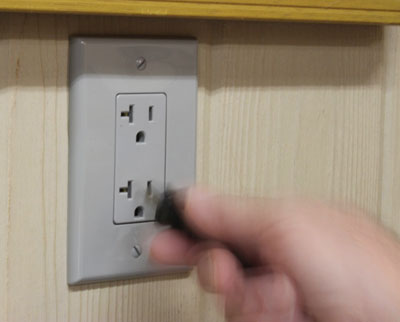
|
Figure 1 - Rapidly plugging and unplugging a battery charger is said
to "re-set" the charger's logic and allow a "dead" battery to be
recharged. Didn't work for me...
|
A rather more interesting internet thread claimed that by putting the battery on its charger and then rapidly plugging and unplugging the charger 10 or 20 times, the charger's logic circuit could be "tricked" into charging a failed battery. The guy even rambled off some plausible-sounding science to support his claim. So I tried that trick, too. On the second try, it almost seemed to work. But in the end, it did not.
Another claim is that putting a rechargeable battery in the freezer overnight and then thawing it out to room temperature will bring a battery back to life. Didn't work when I tried it, but at least it is a relatively benign attempt without sparks and smoke.
Having learned a bit about the chemistry of rechargeable batteries, the fact is, dead is dead. Short of replacing the cells inside the battery enclosure, I don't believe there is a magical fix for a spent battery pack. If you hear of one, let me know. In all likelihood, a dead rechargeable battery has to be replaced.
As a side note, when you do replace a rechargeable battery, please drop the non-working battery off at an approved recycling center. Most big box hardware stores have a receptacle for used tool batteries. The chemicals inside rechargeable batteries are awful. Recycling them responsibly will help keep those chemicals out of the ground.
What About Generic Replacements?
Razors and razor blades. One of the most fundamental marketing ploys relies on us buying a device for which only the manufacturer's consumable product works. Today's printers and ink cartridges are a prime example on steroids. Does anyone really think a color printer that also copies, sends faxes, and scans documents can be designed, manufactured, shipped, sold, and even provide a margin to a retailer for a hundred bucks? The only way that can happen is by charging an outrageous price for each of the required four ink cartridges, and by making sure those cartridges last for the shortest amount of time (or least number of printed pages) they can get by with.
And don't try to cheat the system! I tried an "off-brand" ink cartridge, and in addition to a warning chime and the printer going into immediate stand-by, an ominous, almost threatening, message appeared on the LCD screen. "An unauthorized ink cartridge has been installed. Your printer may be damaged, your warranty will be voided, and a curse will be placed on your family and your family's family for four generations." Okay, that last little bit was made up, but the first two points were absolutely real.
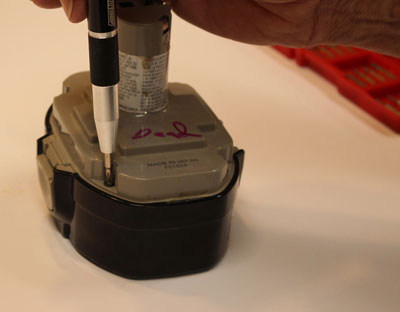
|
Figure 2 - Disassembling a rechargeable battery may require
special tools and is NOT recommended. I only did this to be
able to show you something...
|
Rechargeable tool batteries, like printer ink cartridges, are very specific to the tool for which they are designed. The form factor must match exactly or the battery will not "fit." But unlike ink cartridges, tool batteries are not the "razor blade" profit center for most tool manufacturers.
So why are spare and replacement tool batteries so expensive? Well, as mentioned briefly in last month's column, tool manufacturers do not generally manufacture batteries. They will either find a battery company that will custom make a battery to fit in the specific form factor they have in mind, or they will buy generic batteries and build them into their form factor enclosure themselves. A good example of the latter is the battery I disassembled below in Figure 3. You will note that there are 10 generic NiMH batteries inside the plastic enclosure. The tool manufacturer did not manufacture those batteries, but instead bought them from someone else and built them into their tool's battery enclosure.
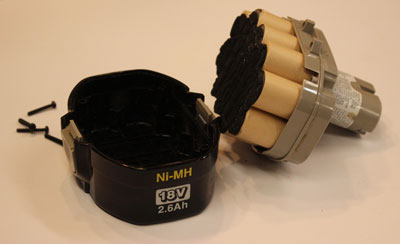
|
Figure 3 - Note the ten standard rechargeable NiMH cells
inside the battery pack.
|
Whether made by, or sourced from, another manufacturer, the batteries in our tools are built into enclosures that are unique to the tool itself. Perhaps the battery is part of the handle of the tool or it is common to a "system" of tools, but it is unique to the product line and manufacturer. A
Festool battery pack
is quite different in form factor from a battery pack made by any other tool manufacturer. Likewise a Makita battery pack will not work in a Bosch tool and a Ryobi pack won't fit a Dewalt tool.
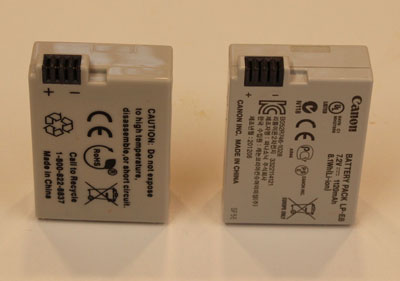
|
Figure 4 - Other than case markings, these two batteries are virtually
identical in appearance, but the "generic" doesn't quite work right
|
The price and potential availability of a generic battery pack is largely a numbers game. If a sufficient number of a specific "form factor" of battery pack is in the market place, a generic manufacturer might see opportunity and attempt to replicate that form factor and sell a "generic" replacement. For example, Figure 4 shows two rechargeable camera batteries. One is a genuine Canon replacement battery and the other is a "no-name" generic replacement. The generic cost about half that of the genuine Canon battery. A manufacturer deemed it financially viable to make this "knock-off" battery because (a) there are a whole lot of Canon cameras in the world that use that battery, hence a huge potential customer audience and (b) the form factor is relatively simple and easy to replicate.
The economics (potential audience size) and complicated form factors in the tool business work together to largely keep generic batteries off the store shelves. If generics are available, they are usually for consumer level tools whose unit sales numbers are measured in the millions.
For example, a company could make a "knock-off" battery for a Ryobi tool and the unit sales potential might be several times what they could sell if they made a knock-off of a Festool battery, simply given the sheer number of Ryobi tools sold to the consumer market place. You will note I was careful to say "unit sales." Of course cost/price considerations come into play here, too. Given the nature of inexpensive big-box store tools, some generic battery manufacturers will determine that making a "knock-off" battery isn't profitable simply because at the price point, many consumers will just buy a whole new tool when the rechargeable battery in their tool stops working.
It is a very interesting market dynamic. And of course, tool manufacturers will have design patents on the "form factor" of their tools that must be considered by a generic manufacturer. They may also have some technology built into the battery/device/charger interface that either cannot be, or cannot be profitably, replicated. Going back to the Canon camera example, the generic battery takes a charge and works okay in the camera, but certain camera on-screen functions, most notably the battery level indicator, do not work with the generic battery.
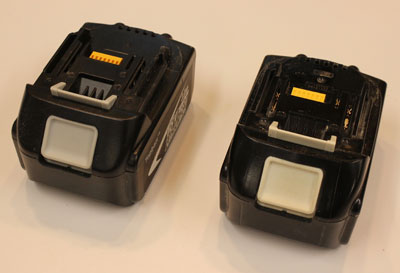
|
Figure 5 - Buying a generic battery seems like a "roll of the
dice." In this case the generic (pictured on left) actually works
better than the original manufacturer's battery. Go figure...
|
For us woodworkers and handy-people, we must decide if a generic replacement battery is worth the gamble. Does such a thing even exist for the tool we have? Is the savings enough to roll the dice? And "roll the dice" is exactly what you are doing when you buy a generic replacement rechargeable battery. Just like I did with the off-brand camera battery, you may find that it doesn't work exactly as it should or is inferior in some other way (doesn't run as long, won't take as many charges, or perhaps won't even charge correctly on your tool's charger). Or, you could get lucky, as I did with the battery pictured in Figure 5. It fits perfectly in the tools for which it was purchased, actually runs longer than the original, and costs about 60% that of its "branded" counterpart.
In some rather rare cases, there are generic battery chargers available. I first ran across this as a result of the video-making process. At any one point I have no less than 8 rechargeable batteries in use and 8 more sitting on chargers, and my production is small by video-making production standards. There are generic battery chargers in the video-making industry that will hold 4, 6, and even 8 batteries at a time. Generally, these multi-battery chargers seem to be made to exacting standards and seem to work well. Their use avoids laying out multiple chargers, finding enough outlets, and the inevitable bird's nest of wires that result.
Making the decision whether or not to "go generic" is tough. In the case of the camera battery, it was for an older camera, the savings was pretty significant, so I rolled the dice. It didn't work out perfectly. In the case of the tool battery, (Figure 5) it is an older "kit" of drill/driver, reciprocating saw, and hammer drill and the price for a brand-name replacement battery was so egregious I took another gamble, and this time I won. Even if such a thing were available, would I strap an off-brand battery on one of my cherished
Festool tools
? Not on a dare. I wouldn't risk harming the sophisticated electronics inside the tool or charger, plus, frankly, I think all things considered, Festool's batteries are priced fairly. I also would not try generic batteries in my video cameras… the equipment is just too doggone expensive to take the risk.
(Page 1 of 3)
1
2
3
Next Page

Steven Johnson is retired from an almost 30-year career selling medical equipment and supplies, and now enjoys improving his shop, his skills, and his designs on a full time basis (although he says home improvement projects and furniture building have been hobbies for most of his adult life). Steven can be reached directly via email at
sjohnson@downtoearthwoodworking.com
Return to the
Wood News Online
front page
|
|
|
|
|